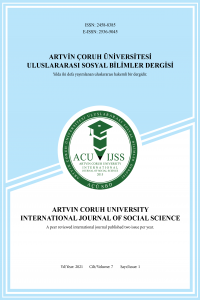Kadın Girişimciler ve İnovasyon; Topluluktan Faydalanma (Crowdsourcing) Yönteminin Getirebileceği Çözümler: Şişli Bölgesindeki Kadın Girişimciler
Tarih boyunca erkek arenası olarak görülen girişimciliğin kadın yüzünün gelişen ekonomilerdeki önemi şimdilerde daha iyi anlaşılmaktadır. Oysaki kadın girişimcilerin sayısı bütün dünyada gittikçe artmakta ve inovasyon başta olmak üzere ekonomiye katkıları da hızla yükselmektedir. Ancak, erkek arenasında varlık göstermeye çalışırken yaşadıkları sorunlar önlerine birer engel olarak çıkmakta ve bu sorunlara çözüm bulmakta çoğu zaman zorlanmaktadırlar. Bununla beraber, inovasyon ve crowdsourcing bu sorunlardan bazılarına çözüm getirebilecek kapasiteye sahiptir. Bu çalışmanın amacı kadın girişimcilerin sorunlarını ortaya koymak ve bu sorunlara bazı crowdsourcing yöntemleriyle çözüm önermektir. Bu anlamda, bu çalışma Şişli Bölgesi’nde rastgele seçilen 26 kadın girişimci ile yapılan görüşmeler neticesinde ortaya çıkan kadın girişimci sorunlarına yeni bir inovasyon yöntemi olan topluluklardan faydalanma (crowdsourcing) ile çözümler önermektedir.
Anahtar Kelimeler:
İnovasyon, Crowdsourcing, Kadın Girişimci
___
- Acs, Z. ve Audretsch D. B. (1993). Innovation and Technological Change: The new Learning, in G. D. Libecap (ed.) Advances in the Study of Entrepreneurship, Innovation and Economic Growth. Greenwich, CT: JAI Press, 109–42. Ahl, H. (2006). Why Research on Women Entrepreneurs Needs New Directions. Entrepreneurship Theory and Practice, September, s. 595-621. Baker, T., Aldrich, H.E., & Liou, N. (1997). Invisible entrepreneurs: The neglect of women business owners by mass media and scholarly journals in the USA. Entrepreneurship and Regional Development, 9(3), 221–238. Bessant, J., Tidd, J. (2007). Innovation and Entrepreneurship. Chichester: John Wiley. Brabham, D. C. (2008, June). Moving the Crowd at iStockphoto: The composition of the Crowd and Motivations for Participation in a Crowdsourcing Application. First Monday, Vol. 13, no. 6, 1-22. Brabham, D. C. (2008, February). Crowdsourcing as a model for problem solving: An introduction and cases. Convergence. Vol. 14, no. 1, 75-90. Barabham, D.C. (2013). Crowdsourcing. MIT Press. London, UK. Brush, C.G. (2008). Women Entrepreneurs: A Research Overview. The Oxford Handbook of Entrepreneurship, Edited by Anuradha Basu, Mark Casson, Nigel Wadeson, and Bernard Yeung. Oxford University Press. Center for Women's Business Research (2002). New Analysis Documents Employment and Revenue Distribution of Women-Owned Firms in 2002 (August 27). www.womensbusinessresearch.org Collins, O. F. ve Moore, D. G. (1964). The Enterprising Man. East Lansing: Bureau of Business and Economic Research, Graduate School of Business Administration, Michigan State University. Cooper, R.J. (1998). A Multidimensional Approach to The Adoption Of Innovation. Management Decision, Vol. 36 No. 8, pp. 493-502. Estellés-Arolas, E. & González-Ladrón-de-Guevara, F. (2012a). Towards An İntegrated Crowdsourcing Definition. Journal of Information science, 38(2), 189–200. Green, S., Gavin, M. and Aiman-Smith, L. (1995). Assessing a Multidimensional Measure of Radical Technological Innovation. IEEE Transactions on Engineering Management, Vol. 42 No. 3, pp. 203-14. Greene, P.P., Hart, M.M., Gatewood, E.J., Brush, C. G., Carter, N.M. (2003). Women Entrepreneurs: Moving Front and Center: An Overview of Research and Theory. Coleman White Paper Series, http://www.unm.edu/~asalazar/Kauffman/Entrep_research/e_women.pdf (Son erişim tarihi: 29.01.2017). Hebert, R. F. ve Link, A. N. (1982). The Entrepreneur: Mainstream Views and Radical Critiques. New York: Praeger Publishing. Herbig, P., Golden, E.J. and Dunphy, A. (1994), The Relationship of Structure to Entrepreneurial and Innovative Success. Marketing Intelligence & Planning, Vol. 12 No. 9, pp. 37-48. Howe, R. (2006) The Rise of Crowdsourcing. Wired, Vol. 14, no. 6, pp.1-4, June. Kolvalainen, A. ve Arenius, P. (2006). Country Report on Finland, in C. Brush, N. Carter, E. Gatewood et al. (eds) The Diana Project International: Growth Oriented Women Entrepreneurs and their Businesses: A Global Research Perspective (New Horizons in Entrepreneurship). London: Elgar. Liebenstein, H. (1968). Entrepreneurship and Development. American Economic Review. (May) 58. Mc Clelland, D. (1961). The Achieving Society. New York: The Free Press. Miller, D. (1983). The Correlates of Entrepreneurship in Three Types Of Firms, Management Science, Vol. 29 No. 7, pp. 770-91. Minniti, M., Arenius, P. ve Langowitz, N. (2005). Global Entrepreneurship Monitor: 2004 Report on Women and Entrepreneurship. Babson Park, MA London: Babson College London Business School. Neergaard, H. (2006). Country Report on Denmark, in C. Brush, N. Carter, E. Gatewood et al. (eds) The Diana Project International: Growth Oriented Women Entrepreneurs and their Businesses: A Global Research Perspective (New Horizons in Entrepreneurship). London: Elgar. Saxton, G. D. & Onook O. & Rajiv K.(2013). Rules of Crowdsourcing: Models, Issues, and Systems of Control. Information Systems Management, 30:2–20. Schumpeter, J. (1934). The Theory of Economic Development. Cambridge, MA: Harvard University Press. Shane, S. ve Venkataraman, S. (2000). The Promise of Entrepreneurship as a Field of Research. Academy of Management Review, 25: 217–26. Slevin, D.P. and Covin, J.G. (1990). Juggling Entrepreneurial Style and Organizational Structure: How to Get Your Act Together. Sloan Management Review, Vol. 31 No. 2, pp. 43-53. Sundin, E. (1988). Invisualizing Women- The Example of Business Enterpriser. Kvinnovetenskaplig tidsskrift, 9(1), 3–15. Thawrani, V. et.al. (2014, May-Jun). Crowdsourcing of Medical Data. Iete Technical Review, Vol 31, No 3. Utterback, J.M. (1994). Mastering the Dynamics of Innovation. Harvard Business School Press, Boston, MA. Zhang, L & Zhang H. (2011). Research of Crowdsourcing Model Based on Case Study. 8th International Conference on Service Systems and Service Management (ICSSSM). IEEE, Tianjin, 1-5. June 25-27. Zhao, F. (2005). Exploring The Synergy Between Entrepreneurship And Innovation. International Journal of Entrepreneurial Behaviour & Research Vol. 11 No. 1, pp. 25-41. TÜİK (2017) http://www.tuik.gov.tr/PreHaberBultenleri.do?id=21529 (Son erişim: 27.01.2017).
- ISSN: 2458-8385
- Yayın Aralığı: Yılda 2 Sayı
- Başlangıç: 2015
- Yayıncı: Artvin Çoruh Üniversitesi
